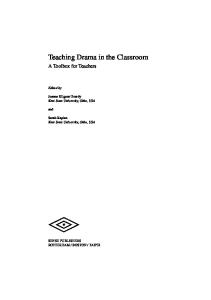A Handbook for Medical Teachers
Since the publication of the first edition of this book in 1983, A Handbook for Medical Teachers has established itself as an ideal resource for new and established teachers who frequently still have little opportunities for education training. Its popula
- PDF / 10,164,485 Bytes
- 224 Pages / 612 x 792 pts (letter) Page_size
- 74 Downloads / 455 Views
A HANDBOOK FOR MEDICAL TEACHERS Fourth Edition DAVID NEWBLE, BSc(Hons), MBChB, MD, FRACP, DipEd Professor and Head Department of Medical Education, University of Sheffield, UK, and previously Associate Professor in Medicine, The University of Adelaide South Australia ROBERT CANNON, MA(Hons), MEdAdmin, DipTertEd Associate Professor and Director Advisory Centre for University Education The University of Adelaide South Australia Illustrations by Zig Kapelis, MArch, MURP, DipTCP Formerly Senior Lecturer in Architecture The University of Adelaide, South Australia
KLUWER ACADEMIC PUBLISHERS NEW YORK, BOSTON, DORDRECHT, LONDON, MOSCOW
eBook ISBN: Print ISBN:
0-306-47506-5 0-7923-7092-9
©2002 Kluwer Academic Publishers New York, Boston, Dordrecht, London, Moscow Print ©2001 Kluwer Academic Publishers Dordrecht All rights reserved
No part of this eBook may be reproduced or transmitted in any form or by any means, electronic, mechanical, recording, or otherwise, without written consent from the Publisher
Created in the United States of America
Visit Kluwer Online at: and Kluwer's eBookstore at:
http://kluweronline.com http://ebooks.kluweronline.com
CONTENTS PREFACE
ix
CHAPTER ONE:
HELPING STUDENTS LEARN Introduction How students learn Non-traditional students and their learning Using new technology and learning Learning more effectively Guided reading
1 2 2 5 6 7 12
CHAPTER TWO:
TEACHING IN LARGE GROUPS Introduction The context of large group teaching What about non-traditional students? Preparing for large group teaching Presenting the large group teaching session What active learning strategies are available? Using teaching materials and technology When things go wrong Evaluating large group teaching A concluding thought – if you must ‘lecture’ Guided reading
15 16 16 17 19 23 27 31 33 35 36 36
CHAPTER THREE:
TEACHING IN SMALL GROUPS Introduction The importance of small group teaching What is small group teaching? Managing a small group Structure in small group teaching Introducing stimulus materials Alternative small group discussion techniques Using technology for teaching small groups Evaluating small group teaching When things go wrong Guided reading
39 40 40 41 42 44 46 46 50 50 51 53
CHAPTER FOUR:
MAKING A PRESENTATION AT A CONFERENCE Introduction Presenting a paper Preparing the paper Preparing the abstract and your contribution to the proceedings of the conference What you should do on the day Preparing a conference poster
55 56 56 56 61 62 64 v
Chairing a conference session Guided reading
66 69
CHAPTER FIVE:
TEACHING PRACTICAL AND CLINICAL SKILLS Introduction The attributes of an effective clinical teacher Improving clinical teaching Improving the clinical tutorial Alternatives to traditional clinical teaching Techniques for teaching particular practical and clinical skills Teaching practical and laboratory classes Evaluating clinical and practical teaching Guided reading
71 72 72 73 75 78 80 84 87 87
CHAPTER SIX:
PLANNING A COURSE Introduction Who should be responsible for curricu
Data Loading...











